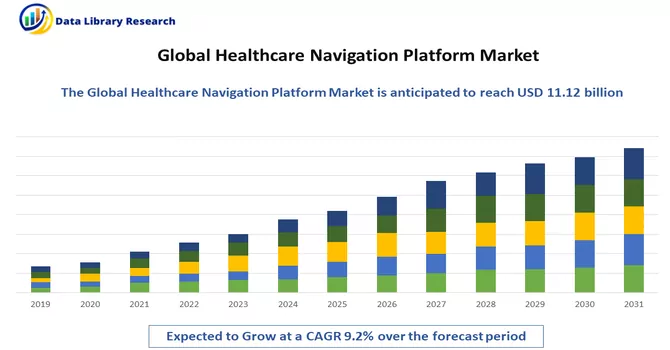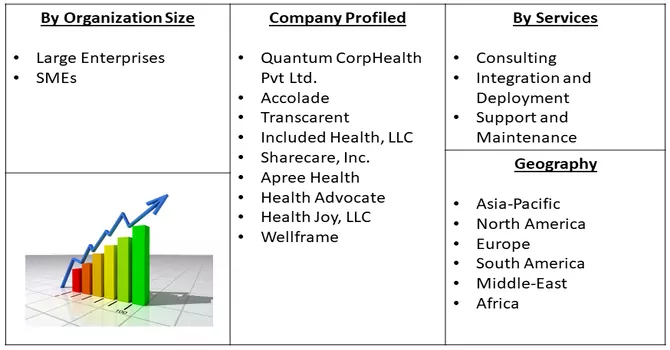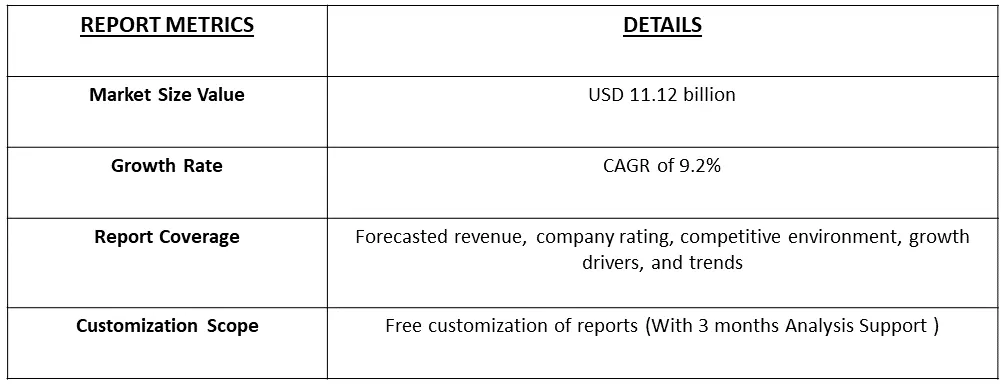The global healthcare navigation platform market size was estimated at USD 11.12 billion in 2023 and is expected to grow at a compound annual growth rate (CAGR) of 9.2% from 2024 to 2031.

Get Complete Analysis Of The Report - Download Free Sample PDF
A Healthcare Navigation Platform is a comprehensive digital solution designed to streamline and enhance the healthcare experience by integrating various tools and features. It offers functionalities such as appointment scheduling, a provider directory with detailed information, health insurance management, telehealth integration for remote consultations, wellness and health programs promotion, health records and data management, cost estimation tools, educational resources about medical conditions, and care coordination among healthcare providers. With mobile accessibility, these platforms aim to empower users to navigate the complex healthcare landscape, make informed decisions, and access services conveniently, ultimately contributing to improved patient engagement and better health outcomes. These platforms may be provided by healthcare organizations, insurance providers, or specialized third-party entities focusing on healthcare technology solutions.
The healthcare navigation platforms market is driven by a confluence of factors shaping the contemporary healthcare landscape. As the demand for patient-centric care rises, individuals seek personalized healthcare experiences, prompting the need for platforms that simplify the complexity of the healthcare ecosystem. The integration of digital health solutions, such as telehealth and mobile health applications, further fuels the demand for comprehensive Healthcare Navigation Platforms. Focus on preventive healthcare, government initiatives, and ongoing healthcare reforms contribute to a favourable environment for platform adoption, enhancing patient engagement. Continuous technological advancements, particularly in artificial intelligence and data analytics, add sophistication to these platforms, providing personalized insights. Escalating healthcare costs drive the need for tools offering transparency into expenses, a role fulfilled by Healthcare Navigation Platforms. The surge in patient empowerment, coupled with market competition and innovation, ensures the continual evolution and enhancement of these platforms, solidifying their role as essential components in modern healthcare ecosystems.
The Navigation Platform Market is undergoing transformative trends that are reshaping the landscape of navigation solutions. Notably, the integration of Artificial Intelligence (AI) is enhancing platforms with intelligent and personalized navigation capabilities, while augmented reality (AR) is gaining ground for improved situational awareness. Multi-modal navigation solutions that seamlessly integrate various transportation modes are on the rise, aligning with the demand for comprehensive mobility options. Real-time data and predictive analytics are becoming integral, offering dynamic adjustments and up-to-the-minute information. Voice-activated navigation systems are increasingly adopted for hands-free operation, and smart city integration is optimizing urban mobility. Accessibility features cater to diverse user needs, including voice-guided navigation for the visually impaired. Eco-friendly options and personalized experiences are emerging trends, responding to sustainability goals and user preferences. Security and privacy enhancements address growing concerns, emphasizing the dynamic and evolving nature of the Navigation Platform Market.
Market Segmentation: The Healthcare Navigation Platform is Segmented by Organization Size (Large Enterprises, and SMEs), Services (Consulting, Integration and Deployment, Support and Maintenance) and geography (North America, Europe, Asia-Pacific, South America, and Africa). The report offers the market size and forecasts in terms of volume in metric tons and value in USD thousand for all the above segments.

For Detailed Market Segmentation - Download Free Sample PDF
Market Drivers:
Government Initiatives to Encourage Healthcare IT Usage
Governments worldwide are actively promoting the adoption of healthcare information technology (IT) through various initiatives aimed at enhancing the effectiveness and accessibility of healthcare services. Key efforts include the establishment and enforcement of interoperability standards, financial incentives, and funding programs to encourage the meaningful use of electronic health records (EHRs). Governments also support the creation of Health Information Exchanges (HIEs) to facilitate secure data sharing among healthcare organizations. The expansion of telehealth services is being prioritized, with policies and reimbursement structures evolving to support virtual care. Stricter regulations around cybersecurity, data privacy, and patient consent aim to ensure the protection of sensitive health information. Additionally, governments allocate funds for research and development in healthcare IT, foster innovation, and educate healthcare professionals and the public about the benefits of digital health. These multifaceted initiatives collectively drive the transformation of healthcare delivery through the widespread adoption of technology.
In March 2023, the World Bank and India inked two complementary loans amounting to USD 500 million each to bolster and upgrade the nation's healthcare infrastructure. The loans are dedicated to supporting the Pradhan Mantri-Ayushman Bharat Health Infrastructure Mission (PM-ABHIM), initiated in October 2021 with the aim of enhancing public healthcare infrastructure throughout the country, as stated in an official release by the agency. The funding can be utilized to digitize and modernize healthcare facilities, promoting the adoption of electronic health records (EHRs), telemedicine solutions, and other Healthcare IT systems. This facilitates efficient data management and communication within the healthcare ecosystem. Thus, such developments are expected to boost the growth of the studied market over the forecast period.
Rise in Adoption of AI Technology
The healthcare market is undergoing a significant transformation with the widespread adoption of Artificial Intelligence (AI) technology. AI's impact is evident in diagnostics, where machine learning algorithms enhance the accuracy of disease detection through the analysis of medical images. Predictive analytics powered by AI stratifies patients based on risk profiles, enabling personalized interventions and preventive care strategies. In drug discovery, AI expedites candidate identification and clinical trial optimization, accelerating the overall drug development process. AI-driven virtual health assistants and chatbots enhance patient engagement, offering real-time information and personalized health advice. In January 2024, Palantir Technologies Inc. (NYSE: PLTR), a prominent AI systems provider, entered into a multi-year commercial partnership with Option Care Health Inc. (“Option Care Health”) (NASDAQ: OPCH), the largest independent national provider of home and alternate site infusion services. The collaboration entails the utilization of Palantir's software throughout Option Care Health to enhance patient outcomes and operational efficiency. AIP enables organizations to bring the power of large-language models, and other cutting-edge AI, to their enterprise networks, private data, and core operations - with maximum security and trust. The platform is designed to bring in siloed and disconnected data sources, logic assets, and systems of action into a single common operating picture, enabling users to optimize their decision-making.
Market Restraints:
High Initial Investment Cost of Healthcare Navigation Platform
The healthcare navigation market faces a potential impediment in the form of the high initial investment cost associated with implementing healthcare navigation platforms. The need for substantial financial investment in acquiring and integrating these advanced technologies into existing healthcare systems may act as a deterrent, slowing down the overall growth of the healthcare navigation market. The cost encompasses expenses related to software development, system integration, employee training, and ongoing maintenance. Healthcare institutions and providers may face budget constraints and hesitancy in making such substantial upfront investments. However, it's essential to note that over time, the long-term benefits of improved patient outcomes, streamlined processes, and enhanced healthcare delivery may offset these initial costs, positioning healthcare navigation platforms as valuable investments in the evolving landscape of healthcare services.
The COVID-19 pandemic has significantly impacted the healthcare navigation platform market, bringing about both challenges and opportunities. On the downside, the initial stages of the pandemic witnessed disruptions in healthcare services, as resources were diverted to managing the surge in COVID-19 cases. Routine healthcare appointments and procedures were postponed or canceled, affecting the usual workflow of healthcare navigation platforms. However, the pandemic also underscored the importance of efficient healthcare navigation systems. With an increased focus on remote healthcare delivery and telehealth services, there emerged a heightened demand for navigation platforms to guide patients through virtual consultations, remote monitoring, and accessing pertinent health information. This shift in healthcare delivery models accelerated the adoption of digital navigation solutions, aiming to provide patients with seamless experiences and improve accessibility to healthcare services. Furthermore, the pandemic highlighted the need for real-time information dissemination, crisis management, and accurate data analytics, all of which are integral aspects of healthcare navigation platforms. As healthcare systems continue to adapt to the post-pandemic landscape, the role of navigation platforms in facilitating patient-centric, digitally-driven healthcare experiences is likely to grow, reflecting a long-term impact on the market dynamics.
Segmental Analysis:
Large Enterprises Segment is Expected to Witness Significant Growth Over the Forecast Period
Large enterprises exert considerable influence in the healthcare navigation platform market, leveraging their substantial financial capacity to drive widespread adoption and innovation. With extensive healthcare networks, these enterprises implement navigation platforms at scale across multiple locations, benefiting a larger patient population. Collaborations with leading solution providers and technology companies enable the development of customized platforms tailored to the specific needs of large healthcare organizations. Prioritizing seamless data integration and interoperability, these enterprises aim for comprehensive patient care, streamlining patient journeys and enhancing care coordination. As early adopters of advanced technologies, large enterprises integrate artificial intelligence, machine learning, and data analytics into healthcare navigation platforms for intelligent and data-driven insights. Ensuring compliance with stringent healthcare regulations, these entities engage in strategic partnerships to enhance technological capabilities, contributing to proactive care and population health management. The scalable nature of these solutions addresses the diverse services offered by large healthcare enterprises, solidifying their role as key drivers in shaping the trajectory of the healthcare navigation platform market.
Support and Maintenance Segment is Expected to Witness Significant Growth Over the Forecast Period
Support and maintenance are vital aspects for the effective functioning and long-term success of healthcare navigation platforms. These platforms, designed to improve patient experiences and streamline healthcare processes, rely on ongoing support to address technical issues promptly. Support services include technical assistance and troubleshooting, ensuring that the platform operates smoothly. Regular maintenance activities involve updates, software patches, and optimizations to keep the platform in line with evolving healthcare requirements and industry standards. Since healthcare navigation platforms handle sensitive patient data, robust security measures and compliance with healthcare regulations are paramount. The providers of support and maintenance services play a crucial role in safeguarding data, preventing disruptions, and ensuring seamless integration with other healthcare systems. Their proactive approach includes continuous improvement, user training, and adapting the platform to meet the changing dynamics of healthcare. In essence, a well-established support and maintenance framework is essential for the sustained success and effectiveness of healthcare navigation platforms, contributing to efficient and patient-centred care delivery.
North America Region is Expected to Witness Significant Growth Over the Forecast Period
The dominance of North America in the healthcare navigation platform market is anticipated, with several factors contributing to the region's growth. This includes the widespread embrace of digital health technologies, such as telehealth and health apps, among the population. The region also boasts a notable concentration of large enterprises that are actively investing in solutions to effectively manage employee benefits. Furthermore, a substantial number of employers, placing a high priority on employee well-being and actively investing in healthcare benefits, are fueling the demand for healthcare navigation platforms in the region. In May 2022, Accolade introduced a groundbreaking solution known as Medication Integrated Care. This innovative offering incorporates advanced analytics powered by Rx Savings solutions, specifically designed to assist employers in tackling challenges related to medication affordability, complications associated with prescription medications, and obstacles in care delivery. The platform aims to provide comprehensive support by leveraging analytical insights, enabling employers to navigate issues related to medication costs, enhance prescription adherence, and address barriers to effective healthcare. Through this initiative, Accolade seeks to offer a holistic approach to healthcare management, emphasizing the importance of integrated and data-driven solutions in addressing complex issues within the realm of prescription medications and overall patient care. Thus, such factors are expected to drive the growth of the studied market over the forecast period.

Get Complete Analysis Of The Report - Download Free Sample PDF
The Market Report on Health Benefits Navigation Platform provides a comprehensive analysis of prominent market players, offering insights into their business profiles, expansion strategies, and overarching plans. It delves into a detailed examination of key players, presenting an overview of their operations and strategic initiatives. The report goes beyond a surface-level exploration, providing a thorough understanding of each player's business landscape and expansion endeavours. By highlighting the strategies employed by these market participants, the report offers valuable insights into the dynamics of the Health Benefits Navigation Platform Market, aiding stakeholders in making informed decisions and navigating the evolving market landscape. Key Healthcare Navigation Platform Companies:
Recent Development:
1) In February 2023, Experian Information Solutions, Inc. unveiled AI Advantage, a novel product designed to alleviate the challenges associated with the substantial volume of healthcare insurance claim denials. Leveraging Experian's extensive expertise in big data insights and solutions throughout the healthcare value chain, AI Advantage aims to enhance services and care for patient consumers.
2) In May 2022, Accolade introduced Medication Integrated Care, an inventive solution equipped with advanced analytics driven by Rx Savings solutions. This offering is tailored for employers, addressing concerns related to affordability, complications with prescription medications, and obstacles to care. The innovative approach seeks to provide employers with effective tools to navigate the complexities of healthcare and improve overall health outcomes for employees.
Q1. What was the Healthcare Navigation Platform Market size in 2023?
As per Data Library Research the global healthcare navigation platform market size was estimated at USD 11.12 billion in 2023.
Q2. At what CAGR is the Healthcare Navigation Platform market projected to grow within the forecast period?
Healthcare Navigation Platform Market is expected to grow at a compound annual growth rate (CAGR) of 9.2% over the forecast period.
Q3. What are the factors driving the Healthcare Navigation Platform market?
Key factors that are driving the growth include the Government Initiatives to Encourage Healthcare IT Usage and Rise in Adoption of AI Technology.
Q4. What are the factors on which the Healthcare Navigation Platform market research is based on?
By Organization Size, Service and Geography are the factors on which the Healthcare Navigation Platform market research is based.
Data Library Research are conducted by industry experts who offer insight on industry structure, market segmentations technology assessment and competitive landscape (CL), and penetration, as well as on emerging trends. Their analysis is based on primary interviews (~ 80%) and secondary research (~ 20%) as well as years of professional expertise in their respective industries. Adding to this, by analysing historical trends and current market positions, our analysts predict where the market will be headed for the next five years. Furthermore, the varying trends of segment & categories geographically presented are also studied and the estimated based on the primary & secondary research.
In this particular report from the supply side Data Library Research has conducted primary surveys (interviews) with the key level executives (VP, CEO’s, Marketing Director, Business Development Manager and SOFT) of the companies that active & prominent as well as the midsized organization
FIGURE 1: DLR RESEARH PROCESS

Extensive primary research was conducted to gain a deeper insight of the market and industry performance. The analysis is based on both primary and secondary research as well as years of professional expertise in the respective industries.
In addition to analysing current and historical trends, our analysts predict where the market is headed over the next five years.
It varies by segment for these categories geographically presented in the list of market tables. Speaking about this particular report we have conducted primary surveys (interviews) with the key level executives (VP, CEO’s, Marketing Director, Business Development Manager and many more) of the major players active in the market.
Secondary ResearchSecondary research was mainly used to collect and identify information useful for the extensive, technical, market-oriented, and Friend’s study of the Global Extra Neutral Alcohol. It was also used to obtain key information about major players, market classification and segmentation according to the industry trends, geographical markets, and developments related to the market and technology perspectives. For this study, analysts have gathered information from various credible sources, such as annual reports, sec filings, journals, white papers, SOFT presentations, and company web sites.
Market Size EstimationBoth, top-down and bottom-up approaches were used to estimate and validate the size of the Global market and to estimate the size of various other dependent submarkets in the overall Extra Neutral Alcohol. The key players in the market were identified through secondary research and their market contributions in the respective geographies were determined through primary and secondary research.
Forecast Model
